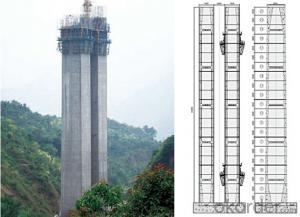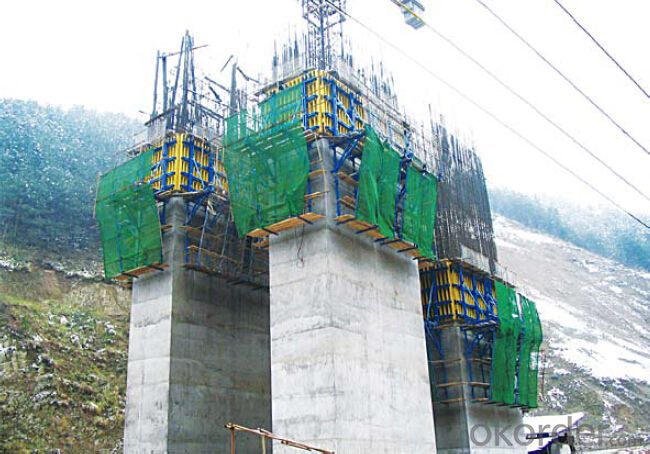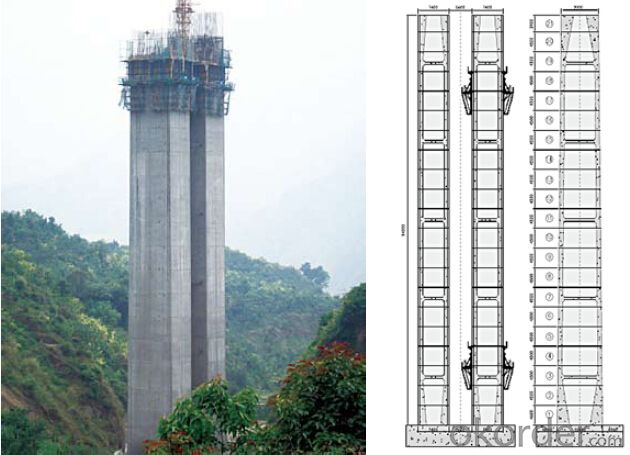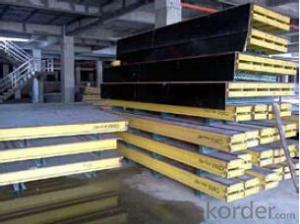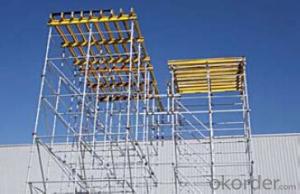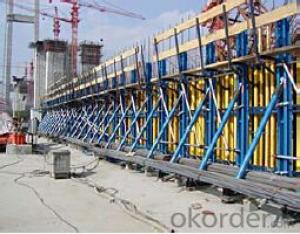Climbing Bracket CB240 for Formwork and Scaffolding systems
- Loading Port:
- Tianjin
- Payment Terms:
- TT OR LC
- Min Order Qty:
- 50 m²
- Supply Capability:
- 1000 m²/month
OKorder Service Pledge
OKorder Financial Service
You Might Also Like
Climbing Bracket CB240 & CB210
They are framework brackets for supporting large-area wall formwork.
Typical applications for the CB240&CB210 are pier and column/shear wall/core walll/ in the
building.
CB210 has smaller size than CB240, it will be cost effective in some condition.
Characteristics:
◆ High bearing capacity
The high loading capacity of the brackets allow very large scaffold units. This saves the number
anchor points required as well as reducing climbing times.
◆ Simple moving procedure by crane
Through the strong connection of formwork together with the climbing scaffold, both can be moved
as a single climbing unit by crane. Thus valuable time-savings can be achieved.
◆ Fast striking process without a crane
With the retrusive set, large formwork elements can also be retracted quickly and a minimum of
effort.
◆ Safe with work platform
The platforms have assembled firmly with bracket and will be climbing together, without scaffolding
but can work safely in spite of your high location.
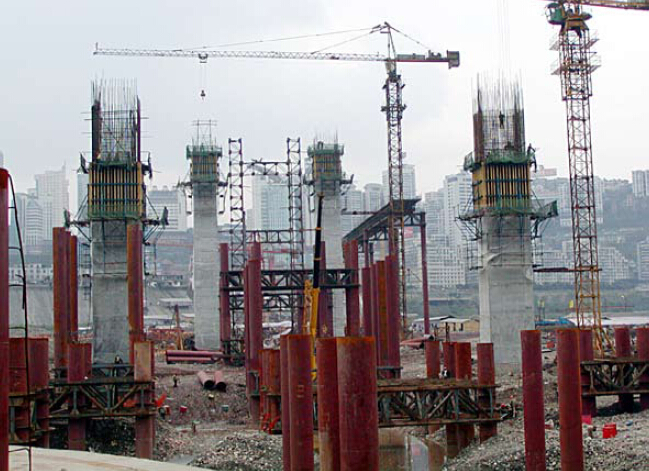
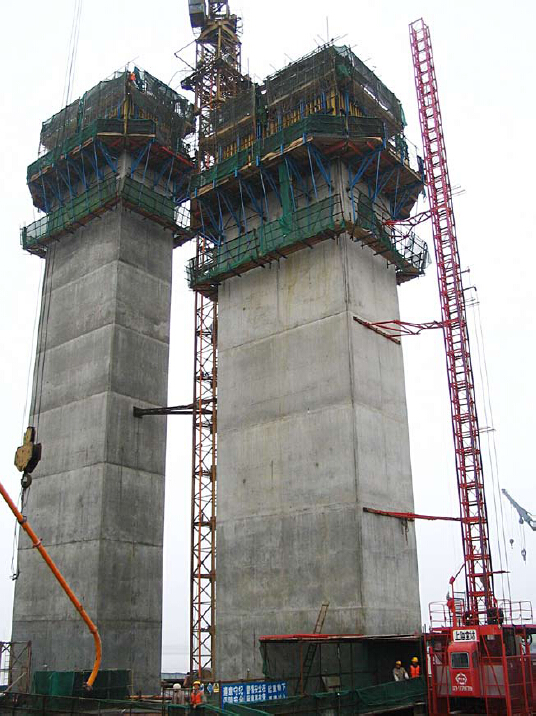
- Q: How is steel formwork installed?
- Steel formwork is installed in a systematic and efficient manner to ensure accurate and sturdy construction. The process typically involves the following steps: 1. Planning and preparation: Before installing steel formwork, careful planning and preparation are essential. This includes determining the desired shape and dimensions of the concrete structure, calculating the required amount of steel formwork panels and accessories, and ensuring all necessary tools and equipment are available. 2. Site preparation: The construction site needs to be prepared adequately. This involves clearing the area of any debris or obstacles, leveling the ground, and ensuring a solid foundation. 3. Positioning and alignment: Steel formwork panels are positioned and aligned according to the planned structure. This is done by connecting and securing the panels using various methods, such as clamps, nuts, bolts, or pins. It is crucial to ensure proper alignment and tightness to prevent any leakage or seepage of concrete. 4. Reinforcement installation: If required, steel reinforcement bars are installed within the formwork to provide additional strength and support to the concrete structure. These reinforcement bars are precisely placed according to the structural design and secured firmly to the formwork panels. 5. Formwork bracing: To ensure stability and prevent any deformation during the pouring and curing of concrete, steel formwork needs to be adequately braced. Bracing helps distribute the load evenly and maintain the desired shape of the structure. Horizontal and vertical bracing systems are used to provide the necessary support and rigidity. 6. Pouring and compacting concrete: Once the steel formwork is securely in place and braced, concrete is poured into the formwork. The concrete is then compacted using vibrators or other suitable equipment to remove any air bubbles and ensure proper adhesion and density. 7. Curing and removal: After the concrete is poured and compacted, it needs to be cured to achieve maximum strength and durability. Curing can be done by various methods, such as covering the structure with plastic sheets or water spraying. Once the concrete has sufficiently cured, the steel formwork can be removed carefully, starting from the top and gradually moving downwards. It is important to note that the installation process may vary depending on the specific project requirements, complexity of the structure, and the type of steel formwork used. Therefore, it is always advisable to consult with experienced professionals or engineers to ensure proper installation and adherence to safety standards.
- Q: What are the different sizes and dimensions of steel formwork panels?
- Different construction needs are catered to by steel formwork panels that come in various sizes and dimensions. The manufacturer and specific project requirements determine the sizes and dimensions of steel formwork panels, although common sizes and dimensions are widely available in the market. Typically, the standard dimensions of steel formwork panels range from 1.2 meters to 2.4 meters in length and 0.6 meters to 1.2 meters in width. These standard sizes are designed for easy handling and transportation on construction sites. Additionally, the thickness of steel formwork panels can vary from 3 millimeters to 6 millimeters, depending on the required load-bearing capacity. Custom sizes can also be manufactured to meet specific project needs, which may be larger or smaller than the standard dimensions depending on the complexity and scale of the construction project. Due to the durability and strength of the material, steel formwork panels are relatively heavy. The weight of a steel formwork panel can range from 30 kilograms to 50 kilograms, depending on its size and thickness. In conclusion, the sizes and dimensions of steel formwork panels can vary to meet different construction requirements. It is important to consult with a supplier or manufacturer to determine the most suitable size and dimension for a specific project.
- Q: Is steel formwork resistant to corrosion?
- Yes, steel formwork is resistant to corrosion.
- Q: Types of building templates? What is clear water template?
- Steel template: in addition to the combination of steel templates, has developed a wide steel template, all steel large formwork, light steel mold, 63 steel frame steel template. The high cost of steel mold, in addition to large projects such as bridges or other buildings, nuclear power plants, reservoirs and other construction sites, has been replaced by building wooden template.
- Q: Can steel formwork be used for concrete structures in marine environments?
- Steel formwork can be used for concrete structures in marine environments, but it requires special considerations and precautions. Marine environments, with their high levels of saltwater exposure and corrosive elements, pose unique challenges for steel formwork. The corrosive nature of the seawater can cause rapid deterioration and rusting of the steel formwork, compromising its structural integrity. To mitigate these risks, it is necessary to use high-quality corrosion-resistant steel, such as stainless steel or galvanized steel, for the formwork. These materials have better resistance to corrosion and can withstand the harsh marine environment for a longer period. Additionally, proper maintenance and regular inspection are essential to identify any signs of corrosion or damage and address them promptly. This may involve cleaning the formwork regularly, removing any accumulated salt or debris, and applying protective coatings to prevent corrosion. Furthermore, it is important to consider the design of the formwork to ensure proper drainage and minimize water exposure. Adequate provision for drainage channels and weep holes should be included to avoid the accumulation of water, which can accelerate corrosion. In conclusion, while steel formwork can be used in marine environments, it requires careful selection of corrosion-resistant materials, regular maintenance, and proper design considerations to ensure its durability and longevity. It is recommended to consult with experienced professionals and engineers who have expertise in marine construction to ensure the success of concrete structures in such environments.
- Q: Can steel formwork be used for tall structures?
- Yes, steel formwork can be used for tall structures. Steel formwork is a versatile and durable option for constructing tall buildings. It offers significant advantages such as high strength, rigidity, and stability, making it an ideal choice for tall structures. Steel formwork can withstand the high pressures exerted by fresh concrete and provide a smooth and even surface finish. It is also reusable, reducing construction costs and environmental impact. Additionally, steel formwork allows for precise customization and can be easily adjusted to accommodate various architectural designs and structural requirements. Overall, steel formwork is a reliable and efficient solution for constructing tall structures.
- Q: How does steel formwork contribute to the overall cost-effectiveness of the construction process?
- There are several ways in which steel formwork contributes to the cost-effectiveness of the construction process. Firstly, the durability of steel formwork allows it to be reused multiple times, reducing the need for frequent replacements and lowering material costs. This durability also leads to reduced maintenance and repair expenses, further enhancing cost-effectiveness. In addition, steel formwork ensures precise and accurate construction due to its excellent dimensional stability. This reduces wastage of materials as the formwork provides a reliable template for the desired shape and size of the concrete elements, resulting in cost savings. Furthermore, steel formwork allows for faster construction cycles due to its easy assembly and disassembly. The interlocking panels and adjustable features make it quick and efficient to set up, saving time and labor costs. The seamless integration of steel formwork with modern construction techniques further enhances productivity and reduces construction time. Moreover, steel formwork offers flexibility and adaptability, allowing for customization and adjustments as per project requirements. This reduces the need for additional formwork or costly modifications, enhancing cost-effectiveness by avoiding unnecessary expenses. Additionally, steel formwork is known for its high strength and load-bearing capacity, eliminating the need for additional support structures. This reduces material and labor costs and provides a safe working environment. In conclusion, the use of steel formwork in construction projects contributes to cost-effectiveness through its durability, reduced material wastage, faster construction cycles, flexibility, and strength. By optimizing resources and enhancing efficiency, steel formwork helps minimize expenses, making it a cost-effective choice.
- Q: What are the different types of form release agents used with steel formwork?
- There are several types of form release agents used with steel formwork, including petroleum-based, water-based, and emulsion release agents. Petroleum-based release agents are commonly used and provide good release properties, but they may have environmental concerns. Water-based release agents are environmentally friendly and provide a good release, but they may require additional drying time. Emulsion release agents are a combination of oil and water and offer a balance between petroleum-based and water-based agents. The choice of form release agent depends on factors such as the desired release properties, environmental considerations, and specific project requirements.
- Q: Can steel formwork be used for curved or irregular-shaped structures?
- Indeed, curved or irregular-shaped structures can be constructed using steel formwork. Unlike conventional timber formwork, steel formwork boasts enhanced flexibility and strength, rendering it ideal for intricate shapes and designs. With steel formwork, it is effortless to bend or fabricate it into any desired shape, facilitating the construction of curved walls, columns, and slabs. Furthermore, steel formwork delivers exceptional support and stability, guaranteeing the precision and accuracy of the eventual structure. Its durability and reusability further contribute to its cost-effectiveness in projects involving curved or irregular-shaped structures.
- Q: How does steel formwork handle architectural features such as openings and recesses?
- Steel formwork proves to be an adaptable construction material capable of effectively managing architectural features like openings and recesses. Its strength and flexibility render it perfect for accommodating these design elements in concrete structures. In terms of openings, such as windows or doors, steel formwork can be easily customized to yield precise and well-defined openings. The formwork panels can be cut or shaped to the preferred size and shape, enabling accurate placement of the concrete around the opening. It also provides stability and support during the pouring and curing process, ensuring the structural soundness of the concrete surrounding the opening. On the other hand, recesses can be effortlessly formed using steel panels specifically engineered to create the desired recessed area. These panels can be shaped or molded to match the architectural design, facilitating a seamless integration of recesses into the concrete structure. Steel formwork allows for meticulous control over the depth and dimensions of the recess, guaranteeing compliance with the design requirements. In addition to its adaptability, steel formwork offers several advantages when dealing with architectural features. Its durability and resistance to deformation enable it to withstand the pressure exerted by the concrete, thereby preserving the formwork's shape throughout the construction process. This is crucial in maintaining the accuracy and integrity of architectural features. Moreover, steel formwork is reusable, making it a cost-effective option for projects involving multiple openings and recesses. The panels can be disassembled, cleaned, and reassembled for future use, reducing the need for new formwork materials and minimizing waste. To summarize, steel formwork is a dependable and efficient choice for managing architectural features like openings and recesses. Its strength, flexibility, and reusability make it an ideal construction material for creating precise and visually appealing architectural designs.
Send your message to us
Climbing Bracket CB240 for Formwork and Scaffolding systems
- Loading Port:
- Tianjin
- Payment Terms:
- TT OR LC
- Min Order Qty:
- 50 m²
- Supply Capability:
- 1000 m²/month
OKorder Service Pledge
OKorder Financial Service
Similar products
Hot products
Hot Searches

